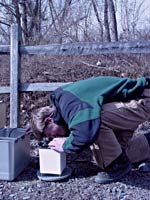While most students are relaxing during spring break, three geology majors will present their research Tuesday, March 26, at the Northeast Section meeting of the Geological Society of America in Springfield, Mass.
The students accompanying Lawrence Malinconico, Jr., associate professor of geology and environmental geosciences, at the conference will be Sarah Gately ’03 (Mount Bethel, Pa.), Randy Copenhaver ’02 (Fairfax, Ver.), and Andrew Fields ’02 (Wilmington, Del.). The students are responsible for preparing the data and conference presentation.
The project is partially supported by the Pennsylvania Geological Survey. For over a year, Gately and Fields have been spending 25 to 30 hours each week in the field, collecting gravity and magnetic data to interpret subsurface structures in the Newark Basin, while Copenhaver has been researching the specific geology and tectonics of the area. The group’s work concerns basins in the eastern margin of North America that scientists believe were left by the rifting of Pangaea, a “super-continent” that contained all present land masses during the Late Triassic and Early Jurassic periods of earth’s history, approximately 200 million years ago.
Gately and Fields have been working in two quadrangles in Reigelsville and Quakertown. The students are collecting data at over 300 stations covering 112 square miles, then bringing the information back to the lab and processing it. The specific goal is to obtain data that can be used to model the structure of the fault margin of the Newark Basin. Their work is an extension of the project done by Meghan Keohane ’98 several years ago, which used similar data to model the structure of the Coffman Hill and Haycock intrusions.
“They take readings on a grid which has a spacing of about a half-mile and take detailed readings across the fault at .2-mile spacing,” says Malinconico. “I suspect that they will end up with over 300 observations. These two projects are part of a larger overall project which I am doing that involves producing geophysical maps (gravity and magnetics) for the Pennsylvania Geological Survey.”
Copenhaver has been gathering structural geological information required for the modeling and preparing the GIS images that will be overlaid on the geophysical maps when they are complete. He also spends time in the field to check the structural information.
In addition to the published abstract for the conference presentation, Malinconico plans to have the group’s work published in a geophysical journal, and the geophysical maps will be published by the Pennsylvania Geological Survey.
“We are focusing a great deal of time and effort into the project and are anxious to combine all of our research and see the puzzle pieced together,” says Gately. “We are also very excited at the opportunity of presenting it at the Northeast Section meeting of the Geological Society of America.”
“Learning how the earth works is a driving force behind being a geology major and a lot of this project is doing just that,” she says. “Working under Dr. Malinconico is very rewarding in itself. He is a professor who cares a great deal about students and the value of their education. The research that he has given us the opportunity to do requires you to be self-driven and independent, but at the same time the equipment that we are using and the techniques that we are learning are not even encountered by some professional geologists.”
Data collection often brings the students out on ice-cold, windy days, notes Gately. “We have been caught in the snow and rain more than once, and then we come back to the lab and spend some tedious hours entering the data into a computer that has a mind of its own,” she says. “We meet a lot of interesting characters, see sights we would have never known about otherwise, and know 112 square miles of back roads like the palm of our hand. The stories we have to tell at the end of one day drive us into the next, and when we are all done, we will know we have accomplished something big.”
Copenhaver also is enjoying the experience tremendously.
“Geology is great because you get to work outside often,” he says. “It just doesn’t seem like work to me when I’m running around, hunting for rocks in the hills of Pennsylvania or wherever I am.”
The project also has been valuable in developing research skills.
“This is a great hands-on experience,” says Copenhaver. “It’s one thing to learn about things in a class, but it’s another to actually get out in the field and put together real research. I’m also learning how to use new tools, like ArcView software for creating maps.”
“I enjoy using the skills that I have learned in the classroom,” he adds. “I’m also excited to be learning new things. I am hopeful that being familiar with ArcView will give me an advantage when applying for jobs and grad school later.”
Copenhaver is a member of the Ultimate Frisbee Club and a DJ for WJRH, the campus radio station. He spent two summers as a laboratory technician for Superior Technical Ceramics.
Gately is a teaching assistant and peer tutor. She spent the January interim session between semesters taking Geologic Evolution of the Hawaiian Islands, an on-site class led by Malinconico and Dru Germanoski, professor and head of geology and environmental geosciences. “It was a great experience to be out in the field studying geology in such a beautiful setting,” she says.
Fields also has taken the Hawaii course as well as another on-site interim session class, Coral Reefs and Caves: The Geology of the Bahamas, taught by Germanoski and Kathryn Schubel, assistant professor of geology and environmental geosciences. The class was based at the Bahamian Field Station, San Salvador Island, a research and teaching facility that was once a U.S. Navy submarine-tracking compound.

Sarah Gately ’03 and Andrew Fields ’02 gather data in the field.




